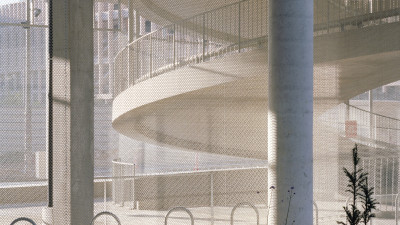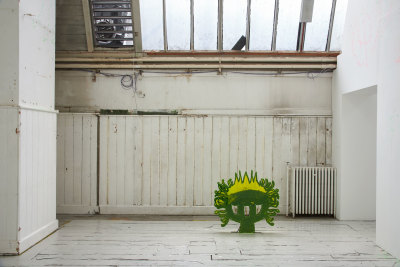‘A smorgasboard of delights’: Ideas for Reimagining Mayfair
‘A smorgasboard of delights’: Ideas for Reimagining Mayfair
By Matthew Carmona
Published 28 October 2014
Planning expert Matthew Carmona, a panellist at the public presentation of our Reimagining Mayfair project, reflects on the intriguing ideas that arose from it.
-
Where would you expect to find multi-coloured hot air balloons tethered to building rooftops, a Victorian institutional building enveloped in foliage, or a swooping mass of African batik fabric suspended as a canopy above you as you walk down the street?
Probably not in London’s Mayfair. Yet these are just some of the ideas that resulted from an open call organised by the Royal Academy, in partnership with the Architects’ Journal, which asked multidisciplinary teams to put forward bold new ideas for reimagining the area of Mayfair directly to the north of their Burlington Gardens building. At the launch of the resulting Reimagining Mayfair pop-up exhibition I had the great pleasure of sitting as part of an ‘expert’ panel convened to comment on the shortlisted entries.
The process reminded me of the great importance of periodically freeing up our thinking by removing the shackles that bind us to the constraints and realities of the real world. Also of the value of the quick and dirty ideas competition as a means to achieve this; giving licence to innovation and creative thinking and to stimulating debate. It is an approach that we should utilise more widely.
Change is in the air
Laid out by Lord Burlington in the 1720s and 1730s, Mayfair has long had an association with wealth, elegance and exclusivity; a position enshrined 200 years later in its iconic position as the most expensive property on the Monopoly board. Whilst the Royal Academy, resident in the area since 1867, adds a strong air of cultural respectability, today these perceptions are sustained through the area’s long association with bespoke tailoring, private art galleries, exclusive clubs and hotels, luxury shopping, foreign embassies and the numerous high value hedge funds that are headquartered there. The advertised £200 to buy a Monopoly house on Mayfair underestimates the real cost some 32,500 times, but as well as its very central location, this may have something to do with the urban qualities of the area – tight grain walkable and animated streets, high quality human scaled architecture and a strong sense of place.
So given Mayfair’s unique status and everything the area has going for it, why instigate a competition to re-think Mayfair at all? The answer is that change is in the air, starting with the renovation of the Royal Academy’s Burlington Gardens building (from 2015), incorporating threats to some of the area’s long-established functions, such as the departure of the American Embassy and impact of escalating rents on tailoring, and including the huge upheavals and transformations that will follow the arrival of Crossrail at Bond Street (and Hanover Square) in 2018. All this means that now is an opportune moment to explore the future of this most select of London’s ‘villages’.
-

6 Burlington Gardens drawing for Warp and Weft by © Weston Williamson + Partners/(uncommon) landscape/Yinka Shonibare MBE RA

Burlington Gardens in Culture, Craft & Commerce by EPR Architects

‘A masterplan for the neighbourhood’ by Andrew Phillips

‘A new setting for 6 Burlington Gardens’ by Andrew Phillips
-
A smorgasbord of delights
From an initial fourteen entries, four teams were shortlisted and each presented a smorgasbord of delights (and a few oddities!) through a range of new and often radical interventions in the historic fabric of Mayfair. The potential was certainly there to shake things up quite a bit.
The first team, Andrew Phillips, VOGT and Henry Coleman, spent much time understanding the historic, and occasionally bohemian, nature of Mayfair, delving into the numerous nooks and crannies that punctuate the urban blocks of the area and which give way to a semi-public world that most users simply pass by. Their project aimed to sensitively reveal and then enlarge a series of new spaces in the city, both formal – enlargement of the road space outside the Royal Academy itself, and informal – a series of new routes carved out of and through Mayfair’s urban fabric taking advantage of the likely redevelopment of its post-war building stock. A unifying new collage floorscape, which rather reminded me of the ‘Letratone’ landscapes I used to create when a student, and a Royal Academy festooned with greenery completed the proposition.
-
DK-CM and Pablo Bronstein titled their submission ‘The May Fair’ and also envisaged a new unifying floorscape, although this time drawing inspiration from the delicate patterns and floor treatments of the Royal Academy’s hallowed halls. These would be used to define a new network of largely traffic-free shared surfaces and would be colonised, in turn, by a range of ephemeral instillations, fanciful pavilions and even ‘cultural hoardings’ (around development sites), programming the spaces with new activity and meaning and evoking the feeling of a continuous May fair.
-

Burlington Gardens watercolour by Irene Djao-Rakatine for Vogt

Burlington Gardens plan drawing for Warp and Weft by © Weston Williamson + Partners/(uncommon) landscape/Yinka Shonibare MBE RA

Wandering print by Henry Coleman

Today | Tomorrow | The May Fair by DK-CM and Pablo Bronstein
-
Yinka Shonibare, Weston Williamson Architects and (uncommon) landscape likewise envisaged a spilling out of the cultural content (quite literally) of the Royal Academy into the surrounding landscape. This idea of breaking down the traditional walls of the gallery and filling the surrounding streets and even the commercial galleries, tailors workshops and retailers with art and performance follows a concept of ‘Warp and Weft’ meant to conjure up the interweaving of different worlds. Like others it included some pedestrianisation and a new piazza outside the Royal Academy, but most dramatically also incorporated a billowing African batik fabric canopy through the streets, designed to transform the public realm beneath and to bathe the spaces, activities and a new floorscape in coloured shadows.
-
Finally, and most dramatic, were the radical interventions envisaged by EPR Architects with Rick Wheal, Kate Malone and James Ulph. Under the theme ‘Culture, Craft & Commerce’, this team evoked a vision of a new immersive landscape, with Mayfair transformed at street and rooftop level by hot air balloons, a water gravity lift, rooftop bridges, big screens, sculptures, rooftop parks, swimming pools, a helta skelta, and a whole lot more. All this would be tied together with the now ubiquitous new unifying floorscape design and pedestrianized streets, replete with self-raising umbrellas that rise from the ground when wet. In sum, a new imaginary cultural landscape of fun.
The value of subversive strategies and crazy ideas
True to the spirit of the best ideas competitions the proposals were both bold and imaginative, even when faced with an area that, on the face of it, seems difficult to reimagine. So what did the schemes have in common?
Apart from the desire amongst all to rip up the timeless granite kerbs and simple concrete and stone paving slabs of Mayfair in favour of something altogether more funky (my own preference would be to keep those but replace the tarmac), it was the subversive elements in each scheme that I enjoyed most and that seemed to unite the four. Thus each featured strategies that subtly or less subtly attempted to disrupt the refined gentility of Mayfair and make us look once again at the potential of this part of London: new routes burying into and through the urban blocks and filling the streets with life; pop-up ephemeral pavilions and year long celebrations; interweaving culture into Mayfair’s commercial and public life in streets dappled with ever-changing colour; and transforming a fifth elevation – the roofs – into an other world of fun and relaxation. Each reveal the potential of unfettered imagination, and what might be possible if only we were able to think (and practice) differently.
For my part, at the start of each academic year I give my students (a mixture of prospective and actual planning, architectural, urban design and property professionals) two weeks and a free rein to create something imaginative and extraordinary, the last two years, coincidently, on nearby Park Lane (the second most expensive property on the Monopoly Board). This exercise has confirmed me in my belief that, when given the chance, everyone can reach into themselves and create something amazing, even a little crazy, as a kind of raw reaction to place. The battle for the rest of my course is then to prevent the students sinking back into a more conventional way of thinking.
This creative mind is vital amongst all built environment professionals, not just architects, and opportunities such as Reimagining Mayfair to remind us of this come around far too infrequently and rarely engage those outside of the architectural bubble. Instead, ideas competitions should be far more part of the norm, helping us to look beyond the everyday and the ordinary, and helping us to consider what might be possible if we think a little differently. Whilst what we come up with may be impractical or simply crazy, and therefore never likely to move beyond a dream, it is just possible that a little of that imagination may rub off on whatever comes next and help us to create better and more stimulating cities. It is my profound hope that a little of this magic dust rubs off on Mayfair which ultimately becomes a more open, fun, fair and beautiful place to be.
Matthew Carmona is Professor of Planning & Urban Design at the Bartlett School of Planning, UCL.











